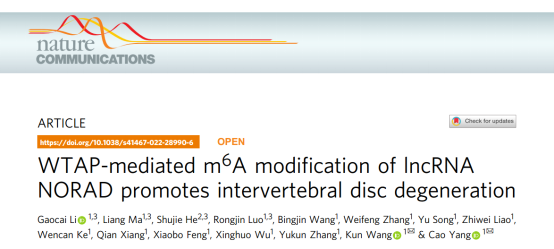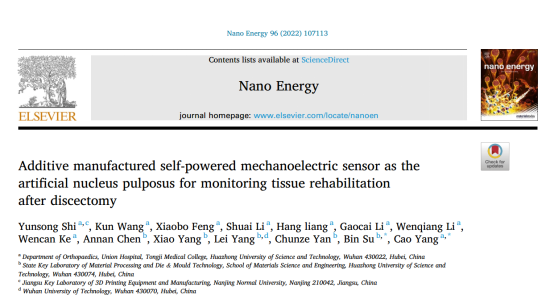Intervertebral disc degeneration is the pathological basis of various degenerative spinal diseases, bringing huge burden and chronic pain to a large number of patients. However, the effective treatment strategies are still missing. Recently, research team of Professor Cao Yang at Department of Orthopaedics, Union Hospital discovered the new mechanism of intervertebral disc degeneration and developed an additive manufactured nucleus pulposus substitute. These findings have been published in the journals of Nature Communications (IF=14.92) and Nano Energy (IF=17.88). Union Hospital, Tongji Medical College, Huazhong University of Science and Technology is the first affiliation and the corresponding affiliation.

“WTAP-mediated m6A modification of lncRNA NORAD promotes intervertebral disc degeneration”
(https://www.nature.com/articles/s41467-022-28990-6)
Prof. Yang’s research team has focused on the research of degeneration molecular mechanism of intervertebral disc degeneration and the effective rehabilitation strategies. In this study, they put forward a regulatory mechanism in the process of NPC senescence during intervertebral disc degeneration from the perspective of epigenetic regulation. The axis of m6A-NORAD-Pumilio-E2F3 demonstrated great significance, which further provides a potential epigenetic therapeutic strategy to treat intervertebral disc degeneration.

“Additive manufactured self-powered mechanoelectric sensor as the artificial nucleus pulposus for monitoring tissue rehabilitation after discectomy” (https://www.sciencedirect.com/science/article/pii/S221128552200194X)
Discectomy is an effective treatment for intervertebral disc degeneration induced herniation. The capability to monitor the mechanical forces on the intervertebral disc after discectomy could develop personalized rehabilitation strategies to benefit the patients’ healthy recovery. Prof. Yang’s research team developed an additive manufactured nucleus pulposus substitute that can sense the mechanical stress in the intervertebral disc with a self-powered capacity. When the substitute senses the stress from the spine bending, the mechanical energy can be converted into electrical signal and the whole mechanical sensing process is self-powered. This research provides a new strategy for patient rehabilitation after discectomy.
Source: http://www.whuh.com/info/1055/9983.htm
Written by: Dept. of Orthopaedics
Edit by: International Exchange Office




